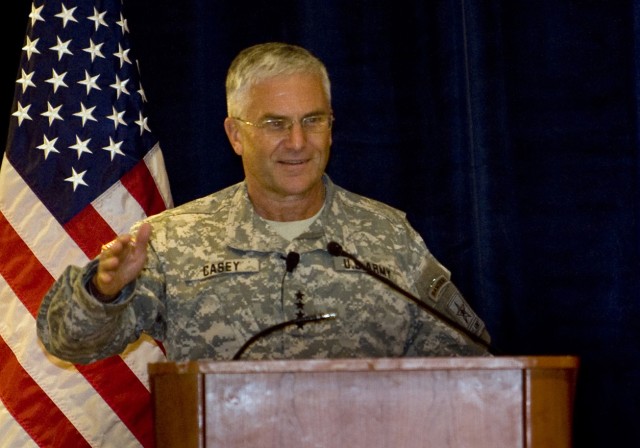WASHINGTON, (May 13, 2009) -- The Army is making progress toward getting current operational needs and long-term requirements back in balance, but there is still a long way to go, the service's top officer said today.
The Army is so weighed down by current demands that it can't do "the things we know we need to do to sustain the all-volunteer force for the long haul and restore our strategic flexibility to do other things," Chief of Staff Gen. George W. Casey Jr. told Pentagon reporters during a media roundtable.
The service is following plans put in place in 2004 and 2007 to address the balance question by 2011. "That sounds like a long time, but in an organization of 1.1 million people that's growing and transforming itself, it's not at all," Casey said.
The general said the next 12 to 18 months are the crunch time for the Army, "because we will actually increase the number of troops we have deployed by about 10,000 as we shift [forces] from Iraq to Afghanistan."
Balance for any military service is important, the general said. "For the Army, it is having procedures revised to deploy a steady stream of trained and ready forces to the combatant commanders," Casey said, "and to do that in a way that is sustainable for Soldiers and their families."
The current war is the longest the country has conducted with an all-volunteer force. Casey said there is "a thin red line" that could break the service if it's crossed.
The most important part of balance officials are working to attain is the time Soldiers spend at home between deployments, the general said. Currently, Soldiers spend a year deployed followed by slightly more than a year at home. Army officials want to get the "dwell time" at home to three years for every year deployed.
"You can fix this two ways: increase the forces, or decrease the need," Casey said.
The Army has grown, and reached its new end-strength limit of 547,000 Soldiers this month - more than two years early. Now the service has to fill the structure, and that will take place over the next few years.
Casey said he anticipates a steady deployment of 15 brigade combat teams over the next few years, and said this would get the dwell-time-to-deployment ratio to 2 to 1. "With the president's drawdown plan [in Iraq], we do better than that in 2011," he said. However, he acknowledged, the enemy gets a vote.
Another aspect of balance is the effort to convert the Army from a garrison-based, Cold War force to the nimble, agile and lean force needed to fight the wars of today. Army units must be versatile and adaptable. Conversion to modular brigades is part of this, but so is converting jobs from what worked to hold off the Soviet Union to what is needed today.
The Army is about 85 percent along in its conversion of about 300 brigades to the modular format.
The transformation also requires 150,000 Soldiers to change skills, and the service is roughly two-thirds through that process, Casey said. "Since this began, the Army has taken down about 200 tank, field artillery and air defense companies and built an equivalent number of military police, engineers, Special Forces and civil affairs units," he said.
Both efforts will be finished in 2011.
Casey wants to put the Army on a rotational cycle like the one the Navy and Marine Corps already use. "As I look to the future, I believe we will have 10 Army and Marine Corps brigades and regiments in combat in Iraq or Afghanistan for a decade," he said. "To do that, we have to be on a rotational cycle, and we must adapt our institutions to support that cycle."
Balance also requires different Army basing, and the service is in the middle of the latest base realignment and closure process that is scheduled to end in 2011. The process will affect roughly 380,000 people over the next few years.
Restoring strategic flexibility also is a key factor in the effort, the general said. Soldiers must be trained to handle all the missions the Army may face.
"As we look to the future, put out about 14 or 15 [brigades] and associated enablers," he said. "If (we) had nine or 10 brigades in Iraq and Afghanistan, that would leave four or five brigades to handle other things." This would allow some brigades to serve regional assignments for combatant commanders and still leave units for a "911" force to deal with emergencies, the general said.
Casey acknowledged he is worried about the long-term impact of repeated deployments on the force and families. Last year, physicians diagnosed 13,000 cases of post-traumatic stress disorder. The Army is dedicating money and resources to help with this stress on Soldiers and their families.
"Another thing that worries me is not being able to draw down in Iraq close to the schedule we have set," he added. "It would be very difficult to sustain the current levels of commitment here for very much longer."
The general also said he's worried about other, unexpected commitments. "I do believe that we will be doing something in the three to five years that none of us is thinking of right now," he said.
This is an era of persistent conflict, and the service will be at this for a while, Casey said. But the bottom line is that if the Army can get through the next 12 to 18 months, "we will get to a very good position here in 2011," he added.


Social Sharing